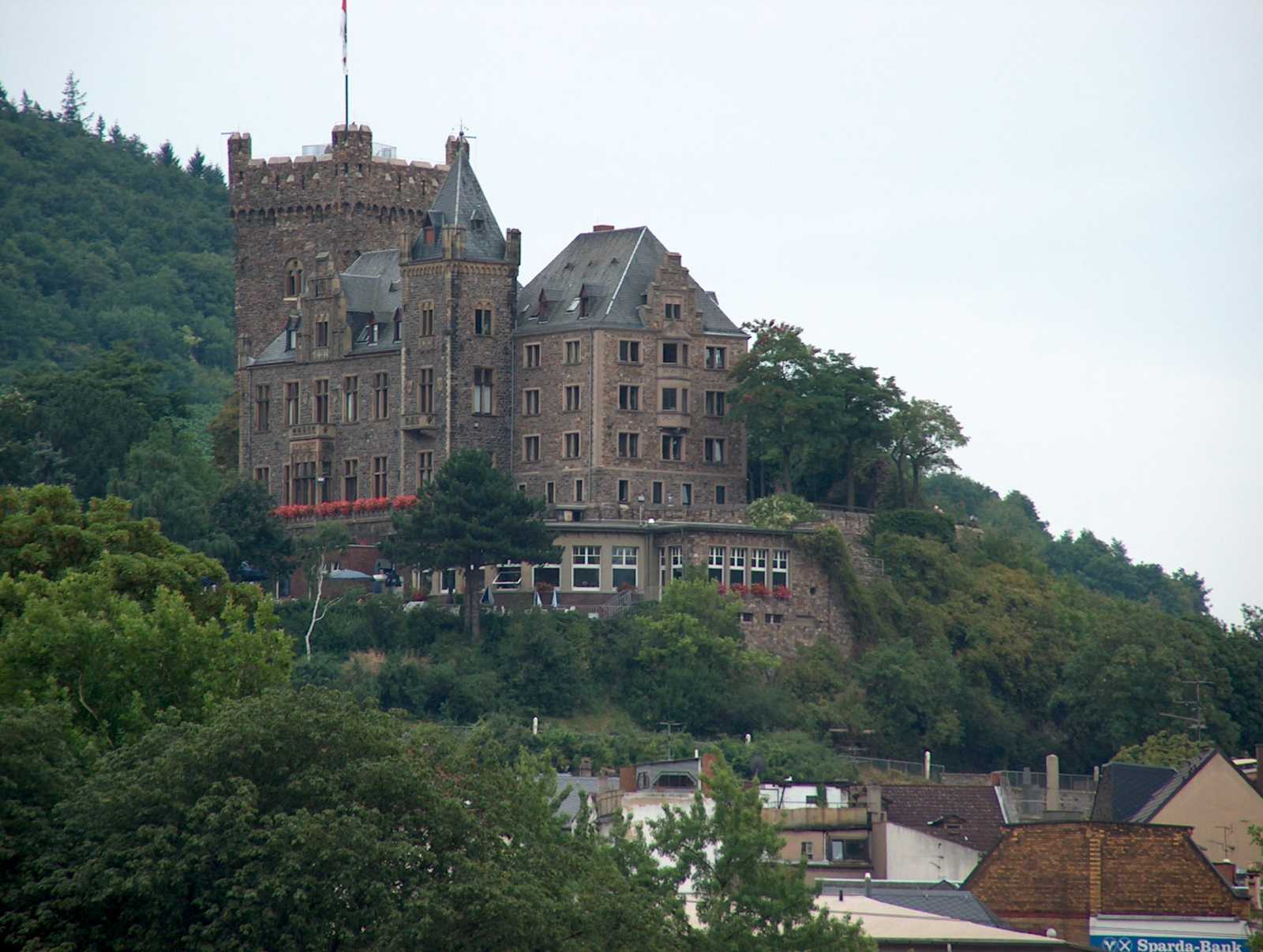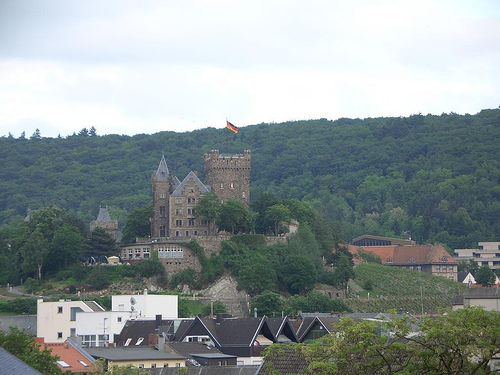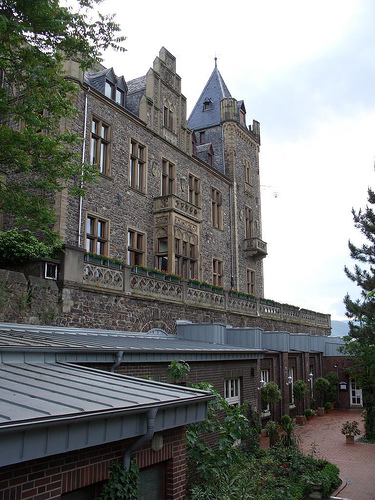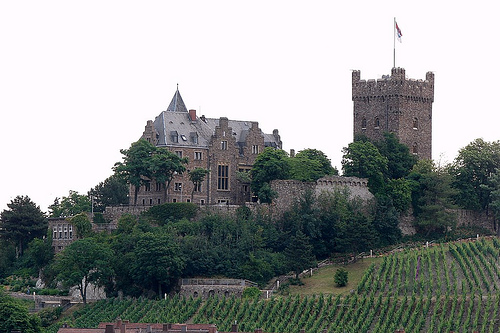
Short History of Klopp Castle: The name of Klopp Castle was first mentioned in 1282. There was destruction in 1165, 1301 and during the 30-year war, and finally by the French king, Ludwig XIV. It was not until the middle of the last century that the wealthy merchant, Ludwig Cron from Cologne, began the generous reconstruction. In 1897 the castle was placed into the possession of the town of Bingen. Since that time it has been the residence of the mayor and the town administration.
Burg Klopp Museum
Burg Klopp, Bingen am Rhein 55411 - Germany
Phone: +49 (0) 67 21 18 40
Burg Klopp is a former castle in Bingen am Rhein which sits overlooking the town and river from its prominent position. It was formerly a home of the Archbishops of Mainz. It was destroyed in both 1689 and 1711, and rebuilt in the 19th century. Bingen’s Heimatmuseum is located in the tower of the castle. The museum displays the history of the town and the castle. It has Roman finds from excavations on display, and many other objects and documents. The museum offers fantastic views over the surroundings. It has a small entrance fee.
Klopp Castle is the landmark of Bingen. Today it houses the city council.
Presumably it was built on Roman foundations. Also the 171 feet deep well probably originates from the Roman time.
The castle - destroyed in 1689 - was the domicile of the castle commissioners from the archbishop of Mainz. Later it housed the chapter.
The castle was rebuilt between 1875 and 1879.
Bingen am Rhein (or Bingen or Bingen on the Rhine) is a city located at the junction of the rivers Rhine and Nahe in the district of Mainz-Bingen, in Rhineland-Palatinate in Germany near the city of Mainz. Bingen is a river port and railroad junction, noteworthy for its premium wine production. It is the seat of administration of, but not administered by the Verbandsgemeinde Rhein-Nahe.
The site of the present city of Bingen was already inhabited by Celts when the Romans arrived in the 1st century BC. The Romans built a wooden bridge across the Nahe and fortified the city, known as Bingium. The present stone bridge attributed to Drusus was actually built in the 11th century. Since 983, Bingen belonged to the Archbishopric of Mainz. After the Napoleonic Wars, Bingen fell to Hesse-Darmstadt, but Bingerbrück (currently a borough of Bingen) fell to Prussia. Bingen and Bingerbrück were united in 1969.
Even before the Romans, there were dwellers here, because the location favoured transport (confluence of the Nahe and Rhine, and the Rhine’s entry into the gorge), a Celtic (Gaulish) settlement by the name of Binge – meaning “rift”. In the early first century AD, Roman troops were stationed in Bingen on the Rhine Valley Road. They changed the location's name to Bingium. There the Romans arose a wooden bridge across the Nahe and a bridgehead castrum. A Roman Mithraic monument, which included a mutilated sculpture representing the nativity of Mithra from a rock, was discovered in Bingen; one of its inscriptions is dated 236.[2]
The presbyter Aetherius of Bingen found sometime between 335 and 360 a firmly Christian and priest-led society. Bearing witness to this time is Aetherius’s gravestone, which can still be seen in Saint Martin’s Basilica[3][4]. After the fall of the Limes, the town became a Frankish royal estate and passed in 983 by the Donation of Verona from Otto II to Archbishop Willigis of Mainz[5]. Under Otto III the Binger Kammerforst (forest) came into being. Under Willigis arose, somewhat up the river Nahe, the stone Drususbrücke (bridge).
The Bingen dwellers strove time and again for independence, which led in 1165 through disputes between the Archbishop of Mainz and the Emperor to destruction. In the 13th century, Bingen was a member of the Rhenish League of Towns. The building of Klopp Castle (Burg Klopp) in the mid 13th century could well be seen as being tied in with this development. A last attempt was the town’s unsuccessful participation in the Peasants' War in 1525. From the Archbishop the Cathedral Chapter of Mainz acquired the town in two halves in 1424 and 1438. Until the late 18th century Bingen remained under its administration. Like many towns in the valley, Bingen suffered several town fires and wars.
From 1792 to 1813, the town was, as part of the département of Mont-Tonnerre (or Donnersberg – both names meaning “Thunder Mountain”), French after French Revolutionary troops had occupied the Rhine’s left bank. In 1816, after the Congress of Vienna, the town passed to the Grand Duchy of Hesse-Darmstadt while today’s outlying centre of Bingerbrück went to Prussia’s Rhine Province, making Bingen a border town until 1871, when the German Empire was founded.
On 7 June 1969, the formerly Prussian municipality of Bingerbrück was amalgamated. On 22 April 1972 came Dromersheim’s and Sponsheim’s amalgamation with Bingen. The epithet am Rhein has been borne since 1 July
1982.
For the State Garden Show in 2008 in Bingen, the Rhineside areas in the town underwent extensive modernization.
Jewish History
Benjamin of Tudela mentioned a Jewish community in Bingen in the mid 12th century. Christian inhabitants attacked the small Jewish quarter on Rosh Hashanah in 1198 or 1199, and the Jews were driven from the city. Jews again lived in Bingen as moneylenders in the middle of the 13th century under the jurisdiction of the archbishop of Mainz. In 1343, French Jews settled in Bingen. In 1405, the archbishop declared a moratorium on one-fifth of the debts owed to Jews by Christians, and subsequently the archbishops repeatedly extorted large sums. Noted rabbis who taught in the small community included Seligmann Oppenheim, who convened the Council of Bingen (1455–56) in an unsuccessful attempt to establish his authority over the whole of Rhineland Jewry. After the proposal was opposed by Moses Minz, the matter was referred to Isaac Isserlein, who rejected the project. The Jews were again expelled from Bingen in 1507, and did not return until the second half of the 16th century. The Jewish population was 465 in 1933, and 222 in 1939 amidst flight and emigration. The 169 Jews who remained in Bingen in 1942 were deported, and only four ultimately returned. The synagogue was demolished in 1945, and the community was not reestablished after World War
II.
Bingen Overview
Bingen am Rhein (or Bingen or Bingen on the Rhine) is a city located at the junction of the rivers Rhine and Nahe in the district of Mainz-Bingen, in Rhineland-Palatinate in Germany near the city of Mainz. Bingen is a river port and railroad junction, noteworthy for its premium wine production


